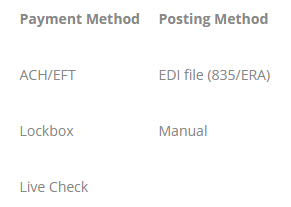 By Sou Chon Young, Hayes Management Consulting
By Sou Chon Young, Hayes Management Consulting
Twitter: @HayesManagement
“For the want of a nail the shoe was lost,
For the want of a shoe the horse was lost,
For the want of a horse the rider was lost,
For the want of a rider the battle was lost,
For the want of a battle the kingdom was lost,
And all for the want of a horseshoe-nail.” – Benjamin Franklin
What’s a horseshoe-nail story got to do with healthcare revenue cycle management? It illustrates that the smallest detail can ultimately make the difference between success and failure. In revenue cycle management, that detail is payment posting. Posting errors can lead to all the major revenue cycle issues: understated accounts receivable, mounting denials, false credits and inaccurate patient statements.
Payment posting has never been a glamorous position – considered a simple “heads-down” data entry job with little impact on the revenue cycle. If that was ever true, it certainly isn’t today.
The massive changes in the healthcare landscape have dramatically affected the professionals responsible for posting payments. Sophisticated new technologies, multiple new payment models and organizations transitioning from one billing system to another means today’s payment posters must handle a much wider range of scenarios.
The bottom line: take your payment posting operation for granted at your own peril. Here are some of the major new competencies you should be looking for in your payment-posting professionals.
Systems savvy
Today’s payment posters must be able to deal with complex new technology solution as billing becomes more digitized. This can be especially complicated when organizations are transitioning between patient accounting systems.
Reconciling EOBs and remits can be especially confusing in that scenario. I recently served as interim manager for payment posting at one of our clients that was moving to Epic from GE/IDX and experienced first hand the difficulty that arose with these reconciliations. The posting team had to review the EOBs to find and calculate the total payments for those accounts that belonged to Epic and those that didn’t (i.e. belonged to GE/IDX, Pharmacy, Vendor, etc.). They had to go through a similar process for the Electronic Remittance Advice (ERA) files although our clearinghouse split the files for us, which made it easier – but still not always straightforward.
Posters need to be able to download reports from multiple banking systems – in our case we were using two different systems. One system held the organization’s money and we had to print our bank statements from that system on a daily basis and reconcile to General Accounting. We used the other system as our ‘source of truth’ for reconciliation and reporting. This required downloading several different reports and massaging and manipulating them to assist with reconciliation, batching for work distribution and month end reports.
Reconciling files is also a crucial task posters need to perform within various IT systems. Migrating from one patient accounting system to another means splitting ERA files to post into the different systems. This requires understanding the splitting and reconciling as well as determining what is required for each system. For example, in Epic a non-check does not require a Cash Control Group (CCG) but once the non-check gets split into two separate files and one portion has a negative amount and the other a positive amount it, no longer is a ‘non-check’ and therefore requires a CCG. Understanding these nuances requires a high level of system knowledge.
Organizational awareness
It’s no longer enough for your posters to be proficient in data entry, happily clacking away in their isolated world. Posters today need to have a wide range of knowledge about the entire organization to do their jobs properly.
For example, the posting group receives mail addressed to all different departments within the organization, including checks that did not belong to patient accounting. Most organizations have several facets (research, charity, clinical trials, satellites, etc.) so checks often come to the area that need to be forwarded to the proper group/department.
Vendor knowledge
Most organizations use lockboxes for collection – often several for multiple vendors. For example, one lockbox was for a vendor that billed and posted our professional claims. However, not all of the payments that went to that lockbox truly belonged there so someone from the team had to manually review the paper EOBs that came through the lockbox to find any accounts that did not belong to the vendor. They then had to make a copy, manually post the money to our patient accounting system, and also submit a transmittal (aka journal entry) to General Accounting since the money was deposited to the vendor’s bank account and needed to be transferred over.
Payor knowledge
Posters must possess in depth knowledge of payors and their processes. In our case, we were not posting with EDI files for several payors (we were a specialized hospital that had patients from all over the country and world). This meant gaining access to several different payor websites, intermediaries, or clearinghouses to download EOBs in order to post payments. Other nuances, per payor, included, but are not limited to:
- PLBs: interpreting provider level adjustments (PLB segment in the 835) also requires familiarity with payors as well as the various ways each payor uses the different PLB reason codes. Some use these adjustments for offsets (e.g. over payment recovery, forward balancing, etc.) and not all payors use the same method for explaining this on EOBs nor are they always on sequential EOBs. Posters often have to discern patterns, for example regular EOBs get produced on Mondays but takebacks only come on Fridays.
- Different payment and posting methods: some payors pay via EFT (electronic funds transfer) but are not utilizing ERA files (either they aren’t offering this – HIPAA violation – or we weren’t ready to accept them), which then required finding and reconciling to the correct EOB, as well as reconciling to the deposit. Below is a table of the different payment and posting methods. Depending on the various combinations, the workflow and reconciliation process will vary.

- Reconciliation: Posters now have tools that will help identify/release ERA files once the payment has been received enabling them to reconcile payment. Some payors release the ERA file prior to the actual deposit that may cause issues with reconciling between the patient accounting and finance department. The poster has to identify and correct these issues.
- Enrollment and how it impacts payment: for hospitals/organizations there is often a need to monitor checks not made out to individual providers. When this happens, the poster typically needs to call the payor to request a new check be issued and the enrollment be updated.
- Denial posting: when it comes to denial posting, not all payors are using the standard HIPAA Claim Adjustment Reason Codes (CARCs) so posters have to interpret the denial and crosswalk the payor proprietary code(s) to the HIPAA CARCs in order to drive the account/claim to the appropriate process/work queue.
- Offsets: for payors offsetting payments but sending account numbers on a remit several weeks or months later – posters must keep track of those and reconcile the money appropriately.
- Use of Claim Adjustment Reason Codes (CARCs): payors may use new codes (e.g. claim adjustment reason codes, remittance advice remark codes, etc.) and when this happens, posters need to work with other members within the revenue cycle team on the proper way to map them.
The healthcare landscape is continuing to evolve and every change can affect the revenue cycle. The increased adoption of technology, bundled payments, shared savings, full risk and value-based reimbursement and an increased number of system transitions present challenges to the revenue cycle process.
Keeping up with these changes and overcoming the obstacles means having strong payment posters in place for your organization. Although experience is helpful, the ability to learn quickly and possessing strong critical thinking and technical skills are even more important. To adapt to all of these changes in the healthcare landscape, the patient accounting payment posting area will also need to grow, learn and obtain new skill sets. Is your organization ready?
This article was originally published on Hayes Management Consulting and is republished here with permission.
